The quality of youngsters that the U.S now produces is getting better and better day by day. Key youngsters include Christian Pulisic at Chelsea and Weston McKinnie at Juventus. These youngsters showed their worth at good clubs and then made that step-up. One player who has already done this step-up is Ajax full-back Sergino Dest. The American has bolstered his place in the first-team squad by providing solid performances and looks to be the future of Ajax’s full-back positions.
In this scout report, we’ll combine statistics and data with footage to analyze the young American full-back in full detail. In addition to the tactics discussed, we’ll also provide tactical analysis on how Dest will fit into the USMNT in terms of the advantages and disadvantages he gives to the team.
Analysing Dest statistically
Before we start analyzing Dest, we’ll conduct some data checks on the player so that we can know his strengths and weaknesses statistically and from there, we can go in and analyze his footage.
Some primers here – I have filtered the full-backs to have played 900 minutes and have set no age filters as I wanted to place Dest among place some veterans and see how the youngster performed.
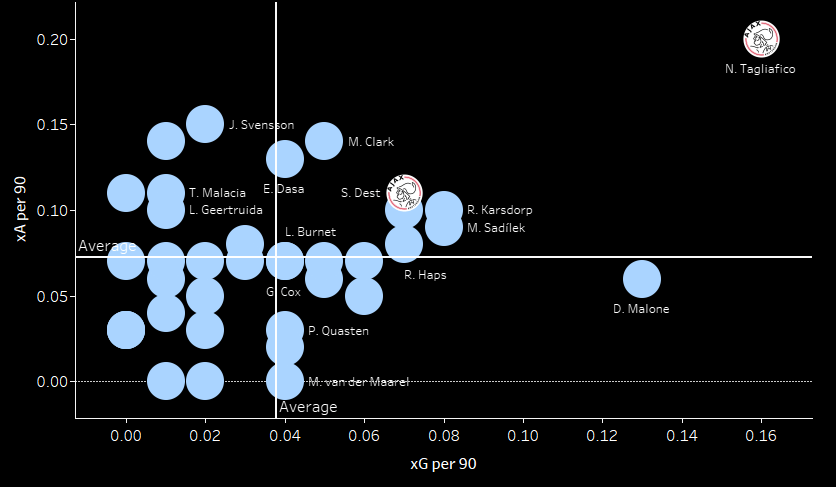
We’ll start with a simple analysis of xG and xA for Eredivisie full-backs for the last season. Here, I have highlighted the Ajax full-backs by their badge and as such, we see both Dest and Nicolás Tagliafico in the Ajax badge.
In this view of statistics, we see Dest perform above-average in xG per 90 and xA per 90 – albeit not by much. For such a young full-back, however, it is a good sign that he tied 5th in xG per 90 and in the top 10 for xA per 90 in the Eredivisie. Now, we must go in deeper and really try to figure out Dest’s strengths and weaknesses.
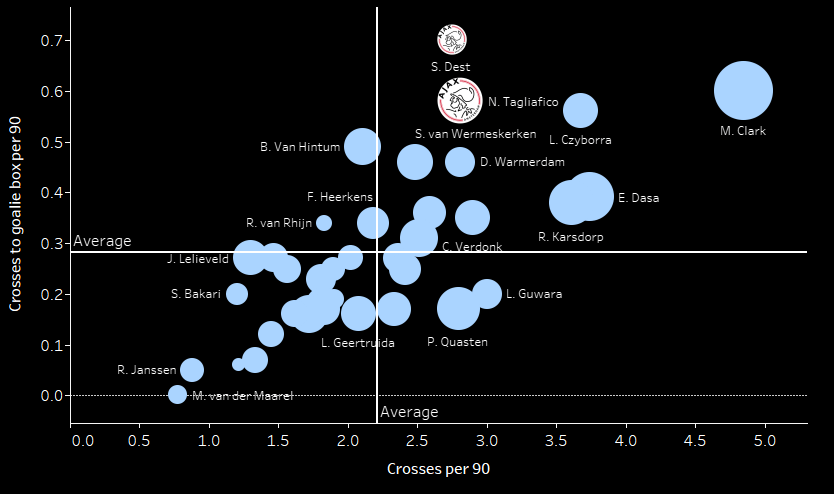
We’ll start with the statistic that all full-backs, more or less, need to do good in – crossing. Here I have graphed crosses to the goalie box and crosses per 90 with deep completed crosses in the size of the players. We see that Dest records above-average crosses per 90 but by a marginal amount. Where Dest excels is in his efficiency – with above-average crosses, he gets the crosses to the goalie box per 90 the most among Eredivisie full-backs.
While he doesn’t record a lot of deep completed crosses – crosses within 20 meters of the opponent’s goal – his excellent performance in getting the ball to the goalie’s box more than makes up for his lack of deep completions.
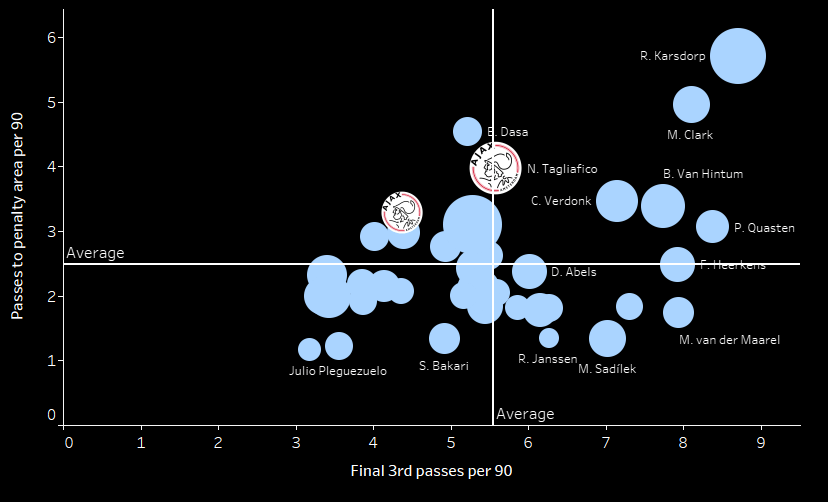
Moving onto passing in an attacking perspective, we see that Dest – the left-ward Ajax badge – performs poorly in this metric. He doesn’t record a lot of passes to the final third and when he does, not a great majority of them make it to the penalty area. This points to the fact that Dest’s ability to use technical skills to create chances is not as advanced – not as much as we saw with his crossing.
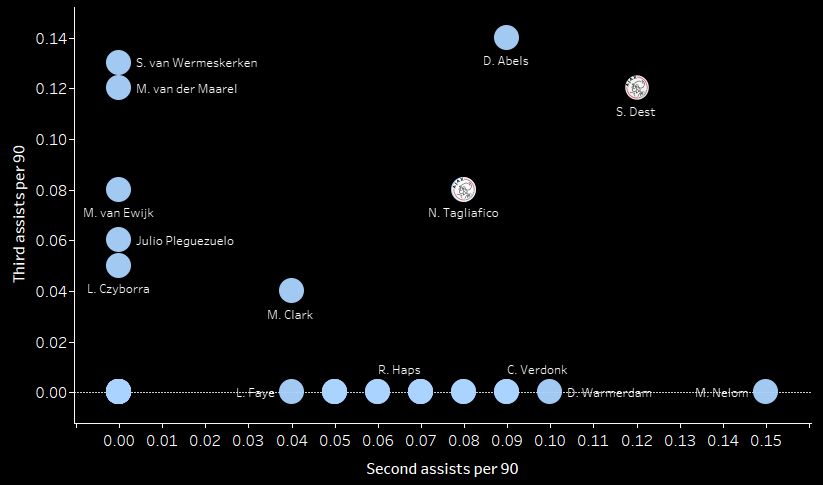
Looking beyond the passing, I have shown third and second assists for the full-backs and we see Dest rank surprisingly high as a hybrid. Many players either lie solely on the second-assist plane – which usually indicates higher involvement in attacking interplay – or solely on the third-assist plane – which usually indicates involvement in the attacking buildup.
With Dest, we see a remarkable ability to be greatly involved in both third and second assists. He ranks second in second assists and tied third in third assists among his full-back which signifies that the young American not only is highly involved in attacking ending interplay – think the final pass that leads to the assist for a goal – but also aids his team in buildup play. These facts mean that while Dest might not be a voluminous passer or attacker, he can be characterized as an efficient attacker – an attribute that makes Dest all the better.
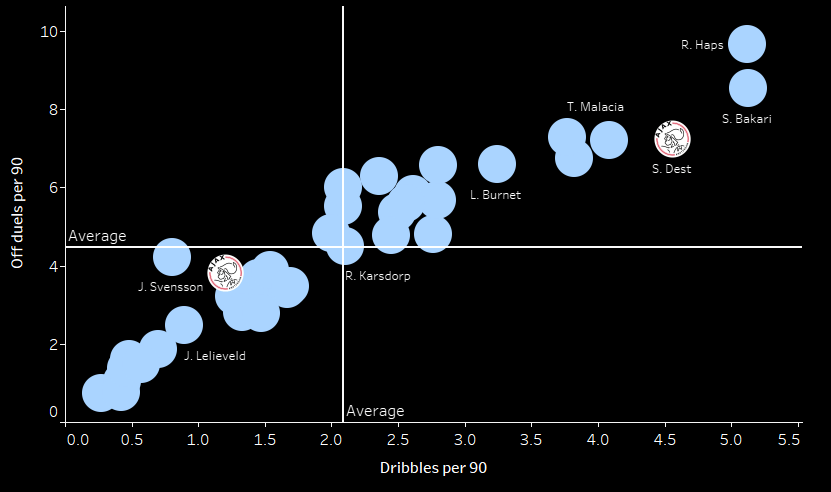
However, not all full-backs are wired to play technical based football. As we see in this graph, Dest falls in the second category in using his pace and directness to trouble opponents. In this graphic that qualifies dribbling abilities, we see Dest rank third in dribbles per 90 and fourth in offensive duels per 90 – a clear sign of just how willing Dest is to take on his man and how many times he’s ready to do this.
This theme of directness in Dest’s plays bleeds into the other fields of his game.
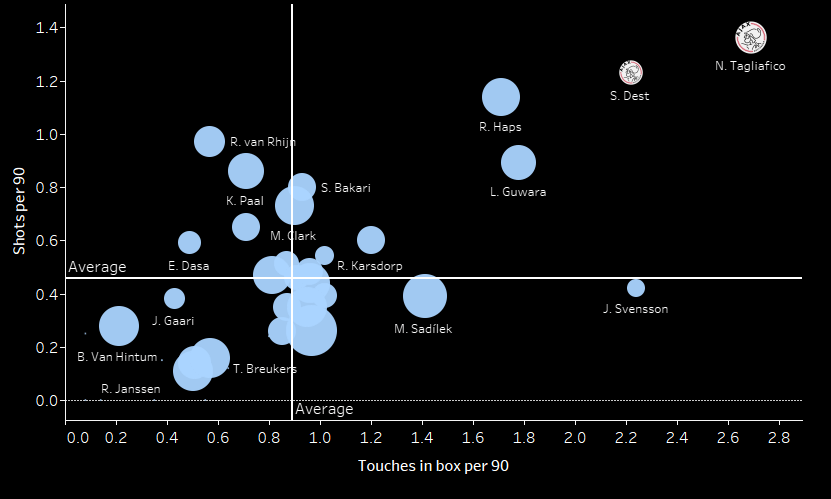
Here I have graphed activity in the box via showing touches in the box per 90 vs shots per 90 with the accuracy in the shots shown in the size of the dots. Dest climbs atop in this graphic as having the second most touches in the box per 90 compared to his full-backs and recording the second-most shots per 90. While he isn’t very accurate – in contrast to his teammate Tagliafico – the ability for Dest to rank this highly in both metrics is a testament to Dest’ strong direct play.
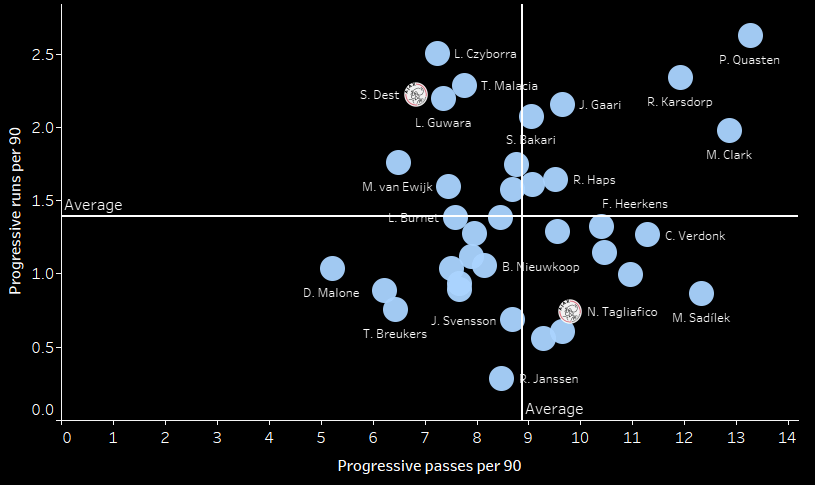
Here is another example of Dest’s strength being direct play. Here, I have charted progressiveness by measuring progressive runs per 90 against progressive passes per 90. In this analysis, Dest does very poorly on progressive passes per 90 – which makes sense as we have seen that Dest isn’t really looking to attack with passes from the deep – however, does very strongly in progressive runs per 90 – a statistic that measures running from the ball that significantly advances the play.
This theme runs strong with what we saw before with Dest doing very strong in dribbling and offensive duels – a by-product of being able to take on your man is having the ability to progress the ball with your runs as well.
It’s now time to look at Dest’ defensive abilities so we can see what type of a defender he is.
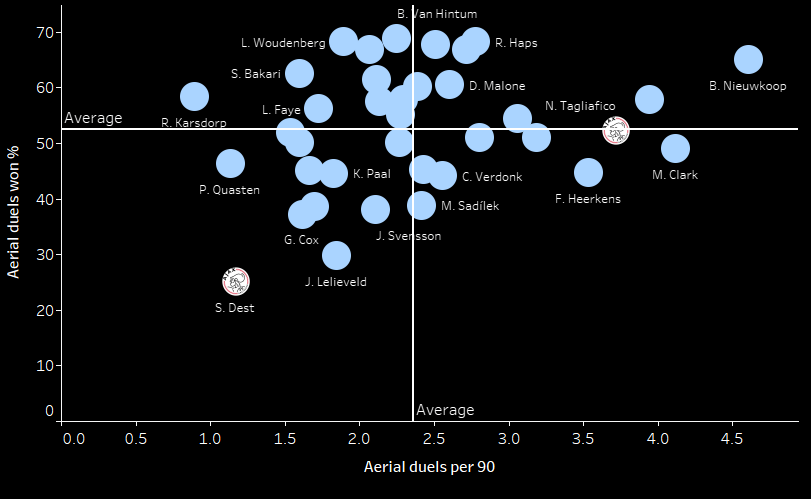
Looking at aerial duels and how many he wins them, Dest is the poorest performer among the full-backs with attempting the lowest amount of aerial duels and not only that, winning only 25% of them. It is clear that in the aerial department, Dest is not the strongest and may be targeted as a weakness if a team is looking to score goals through set-pieces.
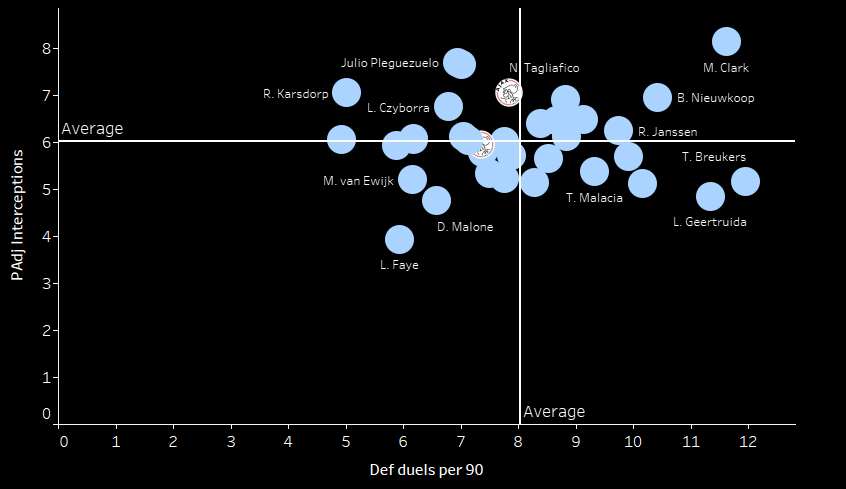
Looking at his defending metrics, Dest performs just about average. He performs about average defensive duels per 90 and is also in par with the average possession-adjusted interceptions for an Eredivisie full-back. As such, it has been clear to see that defending isn’t really Dest’s strong point. Much rather, he excels at attacking via dribbling, running, crossing, getting in the box, and helping and finishing attacking play for his team. Now, we’ll have a look at how Dest performs when considering footage.
Assessing Dest’s off-ball-movement and dribbling
One of the first thing that comes out when Dest is analyzed is the proactiveness in attacking he shows. With every minute of the ball Dest sees, he is consistently making runs and providing the width for his attackers.This is a useful skill that the USMNT will definitely benefit from as oftentimes, their full-backs were prone to not aiding their attackers adequately. With a full-back who is more than ready to provide this, the attackers like Pulisic would immediately find more freedom.
However, Dest’ movements aren’t just blind runs – they are intelligent runs that aim to exploit spaces and open up opponents in intuitive ways.
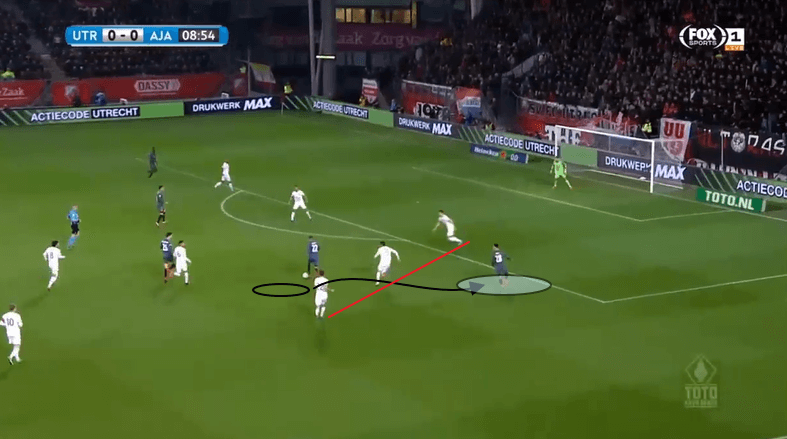
Here is a very good example of Dest’s off-ball movement. The full-back was previously in the half-space and when an attacker moves in, Dest moves to the wing with a curved run which prevents the defenders from committing as they think he is just shifting. This sneaky run allows him to get behind the three defenders and have all the wings to himself.
As we’ll see later in his skill section, Dest then uses his space to cross to his teammates.
Going more analytical, Dest shows some trends in the positions he picks up. This might be due to how Ajax plays however Dest shows incredible maturity in these positions which is a testament to how he can easily play in different positions. This move involves Dest coming inwards as an inverted full-back – occupying the half-space.
This type of positioning has been seen being employed by Pep Guardiola and for Erik ten Hag to place Dest in this position is a testament to how skilful Dest truly is as being an inverted full-back requires not only technical skills but high mobility and constant movement.
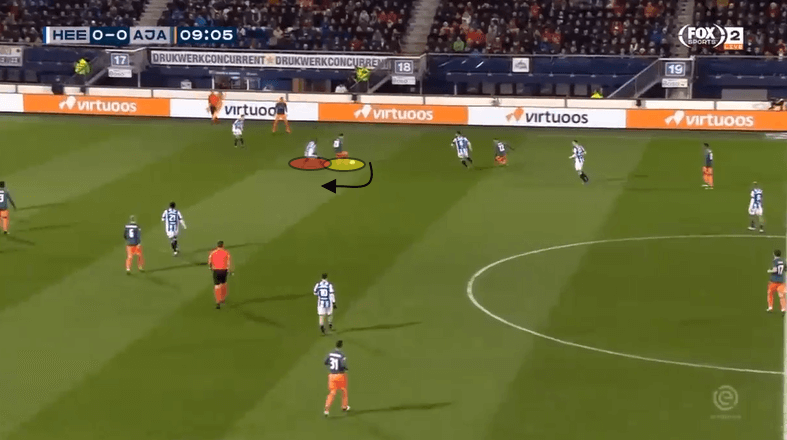
Here is an example of Dest taking up the half-space position high up. Due to this, an opponent comes up near him and pressures him. Receiving the ball in the half-space is already a tough task and Dest skillfully does a feint and turns towards his left.
In fact, this half-space position and an additional -a left-ward movement- from Dest is his favourite type of off-ball movement. This combination allows him to not only draw in the defence but also find space simultaneously.
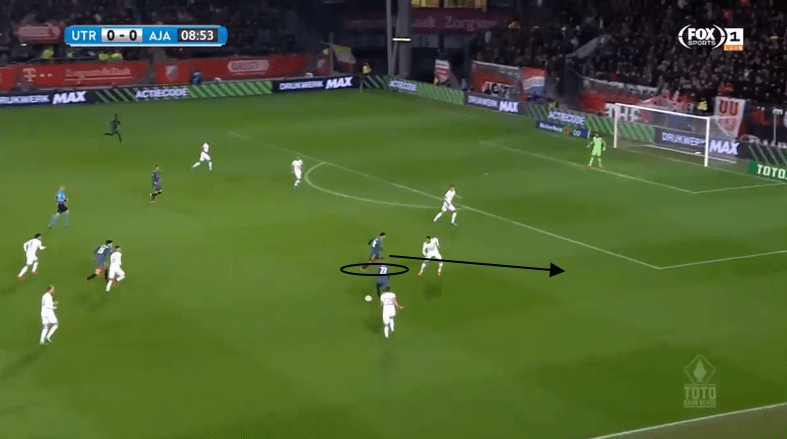
Here we see the same scenario with an attacker coming into the half-space. At the same time, Dest waits until the full-back and midfielder have been attracted in a single line and then starts running opposite to his team-mate. The delay and the opposite movement allows Dest to not only aid his team-mate but also create space from where he can deliver his crosses.
In addition, Dest is always picking up different types of positions that allow him to create space for himself. One of his mannerisms is to go on the touchline and then open his body to the pitch. This mannerism allows his left-leg to pick up the ball from behind and “scoop” it forward which can put his defender over-commit. In addition, he can shift backwards to take the ball centre which adds the unpredictability to his wing movements. Not only that, but Dest’s open body also allows him to quickly press by basically shifting his shape in front of the defender.
Dest, in terms of dribbling, has great qualities that allow him to excel. His pace is a given however he is very nimble on his foot and is able to quickly take a ball down and attack the opponent. This directness always forces the full-back to get sucked into Dest which opens space in the defence.
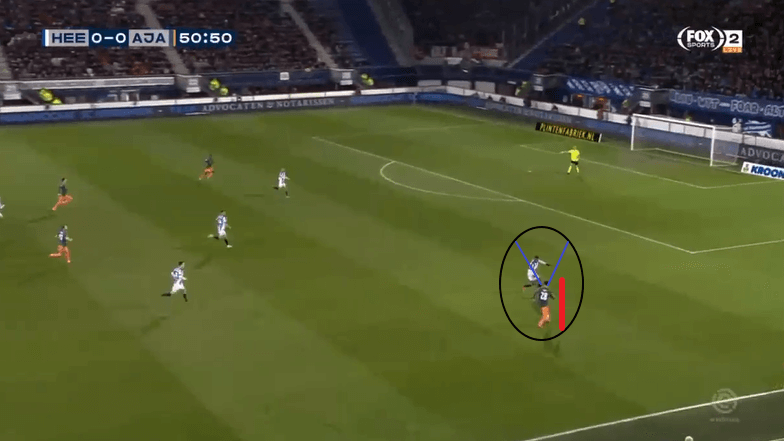
Here Dest takes control of a long ball and directly attacks the opponent. Not only is he very forward slanted, but his eyes are also up on the defender which makes the defender hesitate and really not know where he’ll go. We can see in the defender a hesitation posture which Dest takes advantage of.
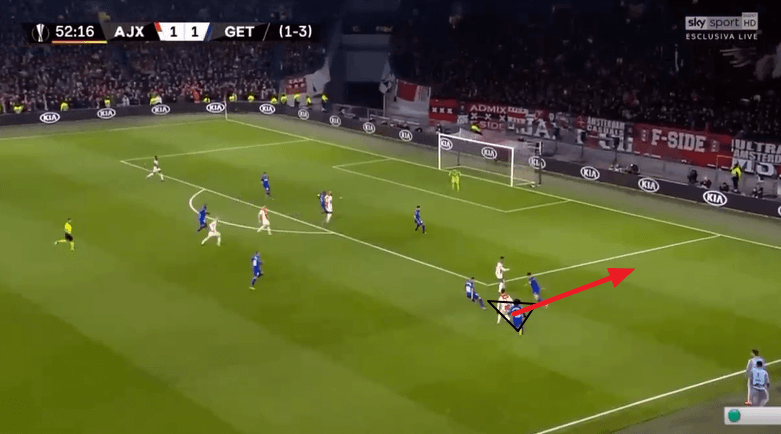
While some full-backs know how to dribble but can’t find the final product, Dest is an exception. Here he excellently dribbles in a triangle and releases a ball to the wing which the Ajax attacker should be at. A miscommunication means that this excellent move is broken down but this goes to show what Dest can create with his dribbling.
Most of Dest’s dribbling occurs in the middle of the opponent’s third which means it’s more for the purpose of helping his team build-up. However, he will also readily dribble in the attacking third to create space for himself to cross.
However, that is not to say that he’s the best at dribbling. While he can feint convincingly and can use touch to get past, Dest’s problems in dribbling are that at times, he gets too close to the opponent. This means that his turns are a tad bit late or his movement is just a tad bit slow which breaks down his dribbling moves and prevents him from taking his take-ons to the final form they deserve.
These intelligent movements will make lives easier for the likes of Morris and Josh Sargent who are looking for fluid interplay to disrupt opposition defence. His runs and proactiveness mean that the attackers will always have an attacking option on the wing but also a full-back who is willing to get involved in the attacking play.
Evaluating Dest’s attacking movements in the final third
Dest is a unique full-back wherein you’ll see him, at various times, being involved in the centre of the pitch. This is a blessing and a curse because, at times, Dest produces moments of magic with this link-up. It is this reason why he ranked so high on second assists per 90. However, for a team that isn’t as structurally sound as Ajax, a full-back abandoning the wing could potentially pose large problems.
This applies directly to the USMNT where Dest’s gravitation towards the centre may open them up for counter-attacks. On the other hand, Dest has also shown that he is not wasteful with what he does with the ball.
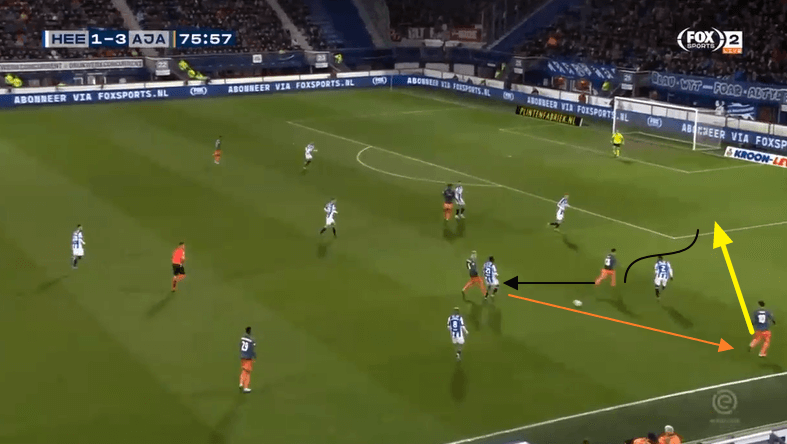
Here we have a great example that combines Dest’s proactive attitude with his ball movement. He passes to a player, shown in black, and then turns to go on a quick run. A team-mate passes to the ‘10’ on the wing who makes the final pass towards the penalty area where Dest picks up the ball. While combinations are rehearsed, Dest’s ability to actually implement with speed and precision means that he is able to successfully create an attack.
This central movement from Dest also cultivates in him getting inside the box plenty of times. It is this central movement with the ball that resulted in the high number of touches in the box we saw before.
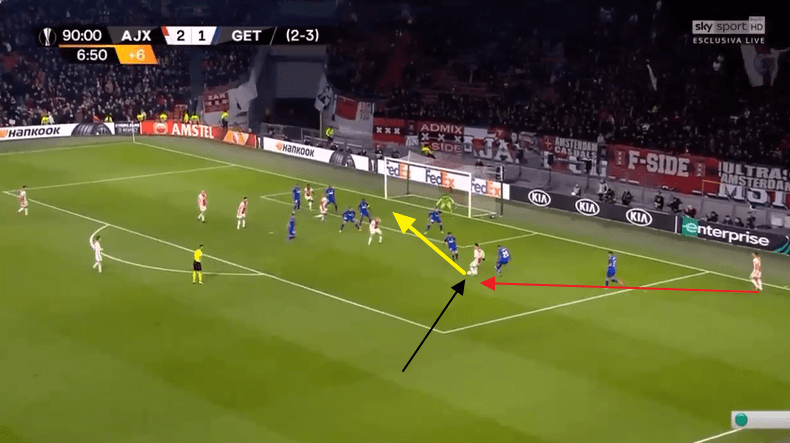
In this example, Dest comes from deep and receives a cut-back. Instead of driving forward, Dest opens his body and needles a through-ball into the centre which is almost met by an Ajax attacker. This chance was a very close chance and almost put Ajax level – such is the quality of Dest inside the box.
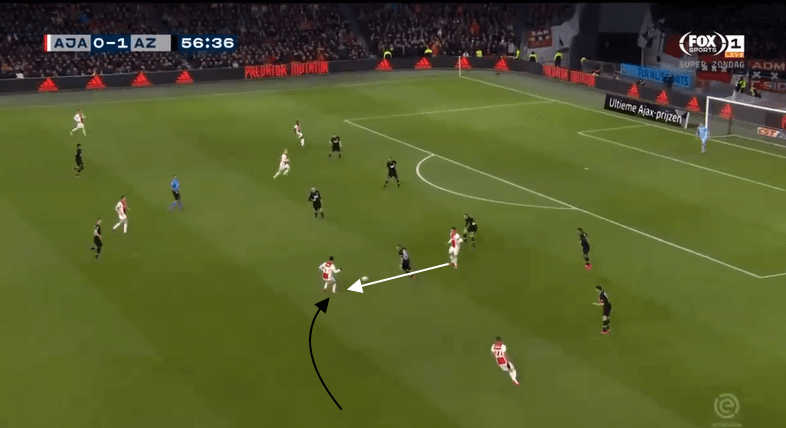
Here’s another sequence which lends itself well for Dest. Dest comes in central and receives a wall pass from the forward. What will be critical to focus is how intelligent Dest is on holding on and releasing the ball in this sequence.
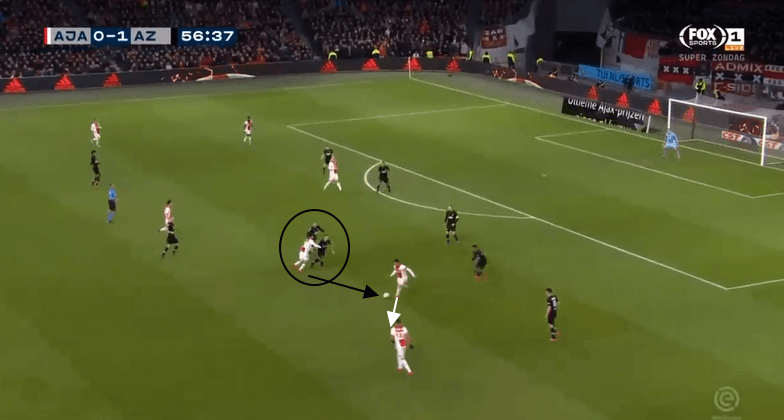
Dest goes forward, waits, and then releases the ball when the forward has come deep enough. His delay causes two defenders to bunch up near Dest. The forward, meanwhile, passes to another attacker. Now, Dest will do something that most full-backs in the situation won’t probably do.
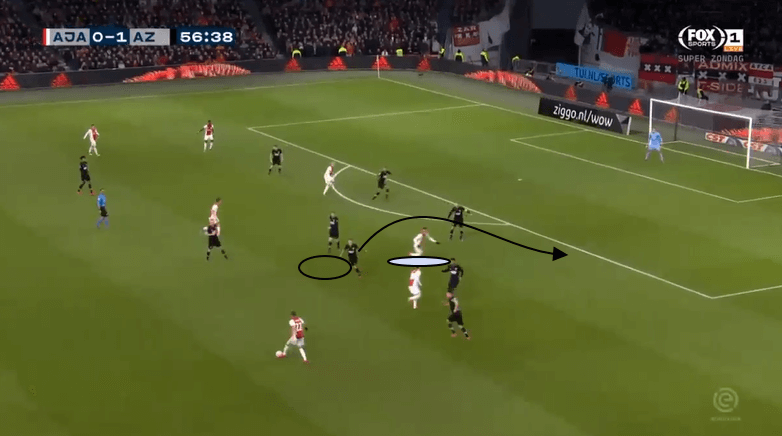
Dest leaves his central positions and makes his way into the wing area. This is a very smart move because the defence is shifted upwards and to the centre which is why there’s space on the wing. In addition, this gives the Ajax attacker an option to make a disguised pass to the wing area which would allow Dest access to the penalty box. One simple run here allows Dest to make himself an attacking danger and give attacking options to Ajax.
As we also saw with his statistics, Dest is a prolific shooter as well – shooting with good efficiency compared to the touches he gets in the box.
However, that is not the only type of on-the-ball movement Dest likes to make. One of his favourite moves is to pick up the ball near his defence and then pass it to a winger and then continue a run in the half-space. Dest then nosedives to the wing again so he can get open space. This movement also aids the attacker as with Dest going outward, the half-space opens up again allowing Ajax to stage multiple movements.
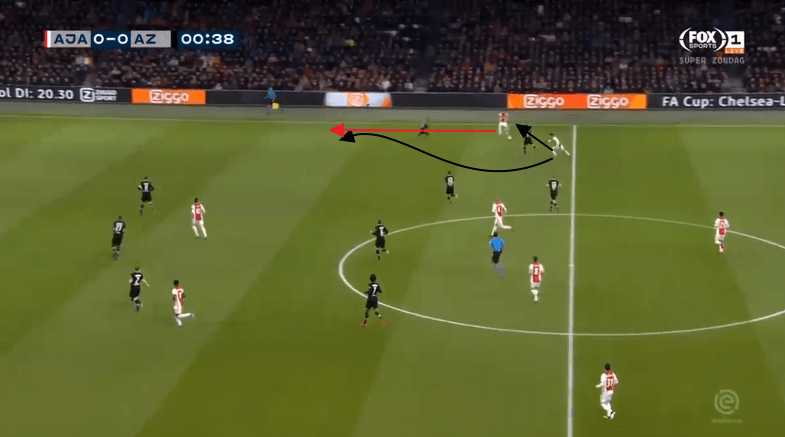
Here we have an example of that movement. Dest gives the ball and then runs inwards-outwards which causes hesitation in exactly how to deal with Dest. Since Dest is running through the half-space, picking the American there will leave the half-space exposed as you follow him. This allows the attacker to come inside and link-up with the forwards.
Letting Dest, on the other hand, affords him the wing-option. Most teams choose to do this as for them, centrality offers better defence than the wing. Dest takes advantage of the fact and uses this wing-space to then start his crossing – something we’ll examine in detail. All in all, this part of his game will have to be tactically configured at USMNT as he can make the attacker better or cause defensive issues for the team.
Examining how Dest crosses
Dest’s best-attacking weapon is definitely his crosses. There are various things to like about Dest’s crosses so we’ll dissect each one.The first reason is the positioning of Dest’s crosses. As seen from his off-the-ball movement and what he does on the ball, Dest often gets into good positions to cross – not too high so that it has to go back and not too low so that he has to exert a lot of power and lose accuracy.
In addition, Dest is great at varying pace on his crosses. One of his favourite places to cross is near the edge of the box, near the goal-side touchline. This seems like a weird place to cross from but time and time, Dest successfully gets into the pocket and makes a cross that is medium-paced in the air. This control allows the ball to go into the centre and be in the air such that clearance becomes tricky.
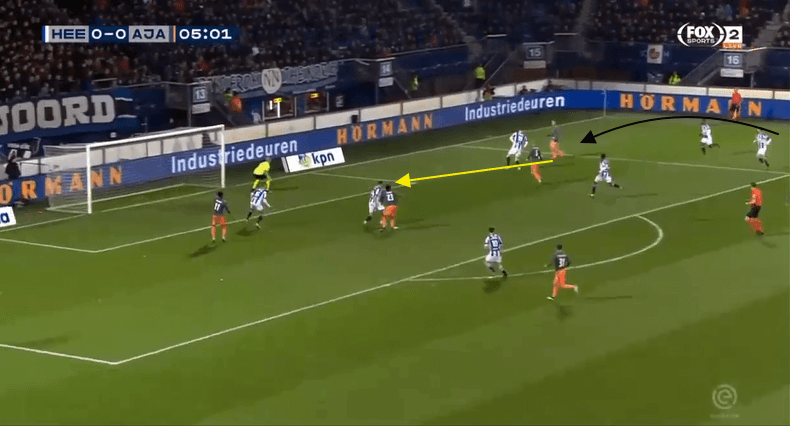
Here is an example of that cross. Dest is right on the touchline and shoots a medium-paced cross to the centre of the goal. It has not too much pace such that any touch will put it wide and neither too slow that defenders can clear it away. As such, it is bound to cause problems.
On the other hand, Dest can put in fast crosses that wizz in the penalty area and pose a major problem as the cross threatens to go in as a deflection.
Lastly, Dest’s accuracy on the crosses is frightening. It is this accuracy that allows him to rank so highly in crosses to the goalie box per 90 since that’s where the traditional forward is always. What is more impressive is that Dest can be accurate even if you don’t give him enough space. He’ll either create space through his dribbling or just put in a cross regardless.
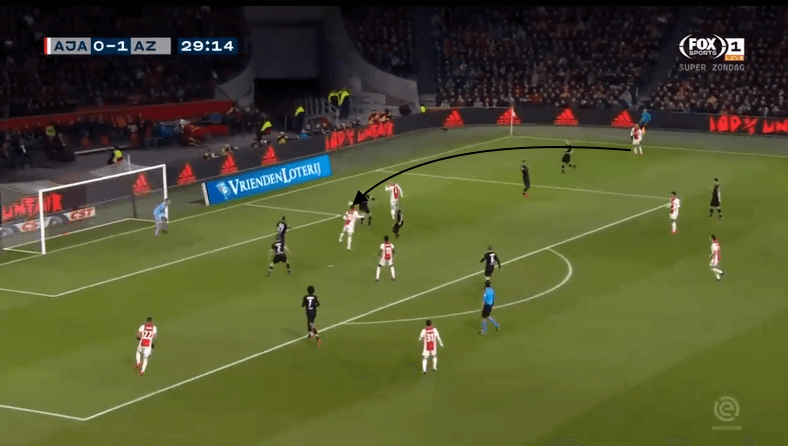
Here Dest, with space, pinpoints a cross to a forward’s head. The only reason Ajax don’t score here is mainly due to the timing and posture of the forward here but put someone taller and this cross goes in. Crosses like these can be very helpful for the USMNT as they have attackers who like to receive these crosses like Jozy Altidore, Jordan Morris, and Pulisic.
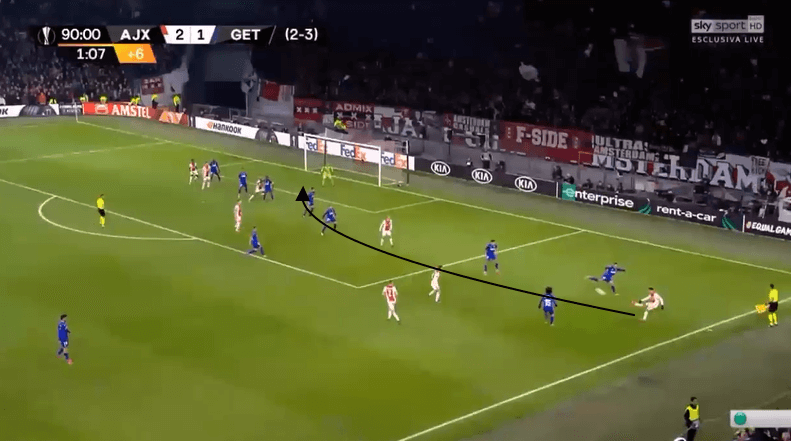
In this example, Dest feints away from his marker and crosses with perfect accuracy in the goalie box with his left foot. It almost reaches an Ajax forward and is some inches away from being a goal. The ability for Dest to do this in the ending stages of a game – against a very physical and demanding Getafe – highlights his talents with the ball.
The fact that most of his crosses make their way in the goalie box poses a dangerous weapon for the USMNT as previous full-backs have been inaccurate or just inconsistent.
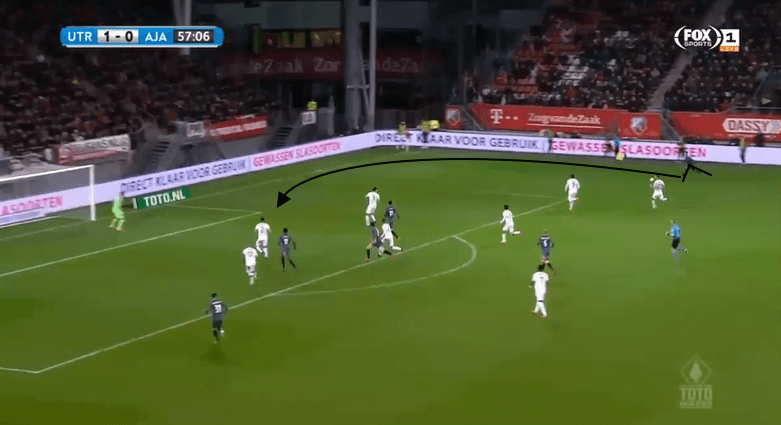
Here is yet another example – this time from slightly deep. Dest correctly lengthens the distance between his feet which allow him to generate the extra power and even with the power, Dest is able to put an accurate ball right in front of the goalkeeper. Combine a mobile attacker like Morris or Pulisic with a static forward and these crosses transform into nightmare situations for opponents.




Comments